#magic flutes
Explore tagged Tumblr posts
Text


The Queen of the Night sequence from Mozart’s “Magic Flute”
The first image by Karl Friedrich Schinkel in 1815 The second by Simon Quaglio in 1818
11K notes
·
View notes
Text

Simon Quaglio (1795–1878) - Queen of the Night, 1818
from Mozart's 'Magic Flute'
#simon quaglio#queen of the night#magic flute#mozart#19th century art#19th century#art#fantasy art#mixed media#painting
4K notes
·
View notes
Text
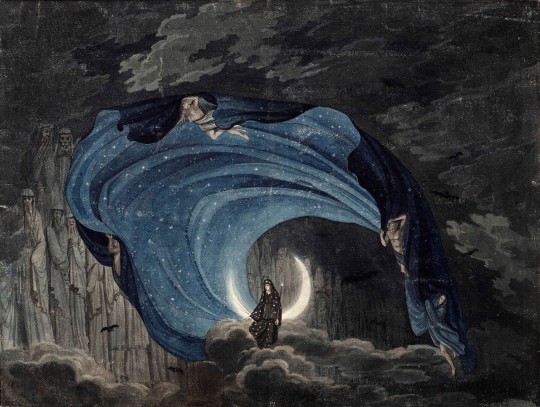
The Queen of the Night (Simon Quaglio, 1818)
11K notes
·
View notes
Text
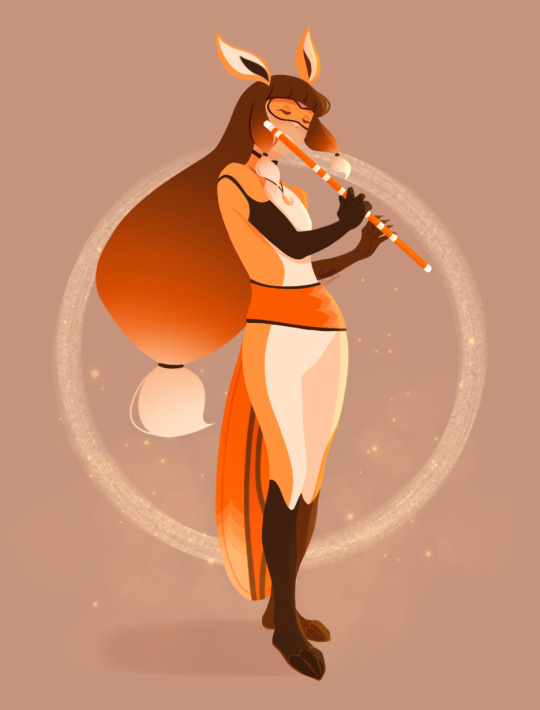
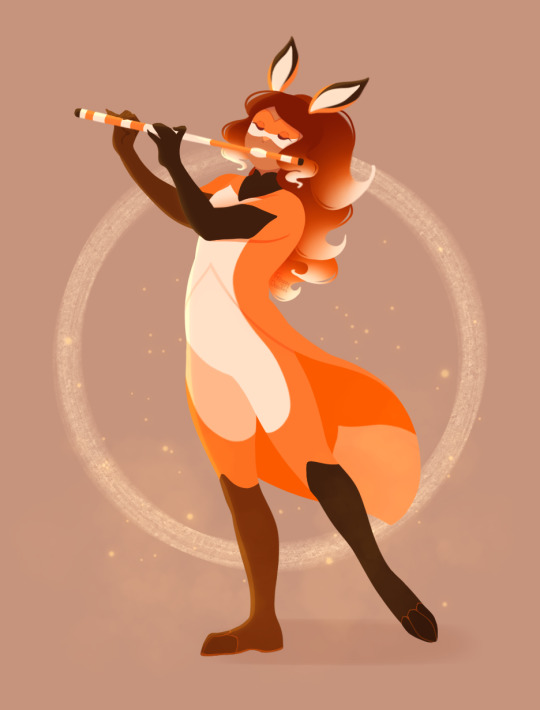
Ballad of the fox
#so does the fox holder magically know the notes needed for battle or do they have to learn it themself#it's most likely the former but Alya picking up an interest in the flute seemingly out of nowhere would be hilarious djdjsjdjsk#she's trying to be sooo secretive about it but everyone knows and assumes she has a big gay crush on the new fox hero#her little reporter ass would be so fucking pissed that she can't correct people LMAO#deranged tags aside. still thinking about turning this into a series.... hmm#volpina#rena rouge#lila rossi#cerise bianca#alya cesaire#mlb#miraculous ladybug
2K notes
·
View notes
Text
Papageno and Papagena meet under the moonlight 🐔🐓

#art#illustration#fan art#papageno#papagena#mozart#die zauberflöte#the magic flute#opera#classical music#classical#Spotify
159 notes
·
View notes
Text
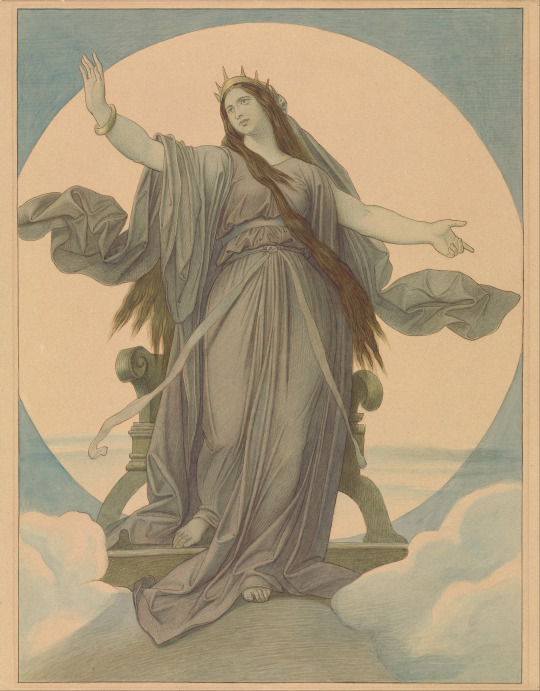
Title: The Queen of the Night Artist: Moritz von Schwind (Austrian, 1804-1871) Date: 1864-67 Genre: drawing for a production of Mozart's Die Zauberflöte Medium: watercolor over graphite Dimensions: 41 cm (16.4 in) high x 31.1 cm (12.4 in) wide Location: Getty Center, Los Angeles, CA, USA
#art#art history#Moritz von Schwind#drawing#illustration#Queen of the Night#Die Zauberflöte#The Magic Flute#Austrian art#19th century art#watercolor over graphite#Getty Center
330 notes
·
View notes
Text
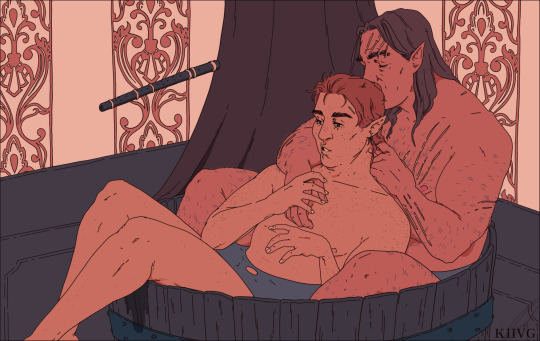

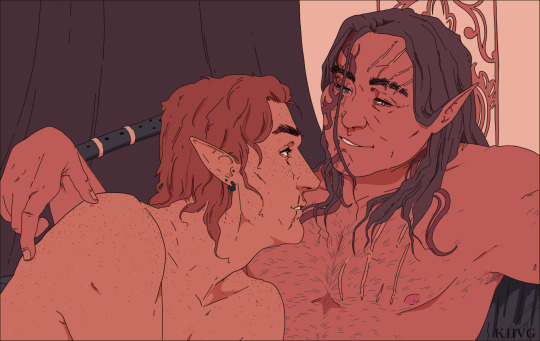
:)
#baldurs gate 3#bg3#halsin#tav#tristan yarrow#halsin x tav#tav x halsin#mxm#so now i have to poat it in this format which is awful so idk what is going on but im so done with this right now goodbye#floating flute is bard magic bye
929 notes
·
View notes
Text
NOT THE OFFICIAL ROYAL BALLET AND OPERA ACCOUNT POSTING THIS
#opera tag#opera#die zauberflöte#the magic flute#queen of the night#memery#this is SO outta pocket lmao#mozart#wolfgang amadeus mozart
133 notes
·
View notes
Text
The Different Portrayals of Papageno in "The Magic Flute" (Die Zauberflöte)
Of all the characters in Mozart's The Magic Flute, Papageno is probably the one most open to interpretation by the singer and the stage director. As I've watched different performances of the opera, the funny bird-catcher seems almost like a different character in each version.
Every singer brings unique qualities to the role, but I've narrowed the most common portrayals down to four – which can be combined with each other too. I've seen baritones give excellent performances in every one of these portrayals, as well as in blends of them.
The Innocent

This is the sweetest portrayal of Papageno and the most endearingly simple-minded. He’s most often portrayed by younger baritones: the more baby-faced, the better. This uneducated, naïve young creature of the woods and mountains is almost a Peter Pan figure (without Peter Pan’s brashness or ruthlessness, though with a little of his boyish cockiness), who has never quite grown up. His childlike qualities include total earnestness as he asks questions with obvious answers, childlike quaking and whimpering in the face of danger, and childlike sobbing in moments of despair. Yet while his failure to “be a man” sometimes tries other people’s patience, no one except Monostatos can really dislike him. His friendly, cheerful, exuberant yet gentle demeanor is filled with natural charm, and the broad, sunny comedy of nearly all his scenes keeps the audience laughing, yet his boyish vulnerability is touching too, even when it’s played for laughs. Most endearing of all is his lively, wide-eyed, unabashed joy in all of life’s most simple pleasures. He might be an unsophisticated man-child, but whatever he lacks in maturity or wisdom he makes up for in zest for life and in warmth of heart.
The Peasant

This is a more mature, down-to-earth Papageno, who clearly represents the common man. He comes across as an average, hardy 28-year-old peasant, lifted straight out of the 18th century Austrian countryside into an exotic fairy tale world. Although uneducated and unrefined compared to Tamino, he’s not particularly naïve, but conveys sound working-class intelligence and practicality, and he often delivers his funny lines with a knowing, snarky wit. This makes him a kindred spirit to classic earthy “comic servant” characters like Sancho Panza or Leporello. His lustiness is also pronounced as he craves good food, alcohol, and female companionship: it’s clear that his desire for a Papagena is carnal, not just emotional. And despite all his fears and foibles, there’s an underlying stolidness to him; a sense of resilience that suits a man whose spent his life working hard to earn a humble living. Ultimately, he fails Sarastro’s tests not because he’s silly or weak, but because he’s just too ordinary for the grandly idealistic world of the priests. This makes him less broadly funny than some other Papagenos are, but it makes him easy for the audience to personally relate to, and easy for them to view as a friend too.
The Odd Duck

This is the most eccentric Papageno. His costume tends to be more wildly feathery than other Papagenos’ and make him look less human and more birdlike. He often has more birdlike mannerisms too: for example, making chirping sounds when he sees a pretty girl, or literally screeching in terror. But even if he’s portrayed as fully human, he’s defined by adorable quirkiness. In contrast to the staid dignity of the upper-class characters who surround him, he has puckish, squirrely energy, with little thought for dull things like “manners” or “social rules,” and his emotions always run free and high, sometimes causing funny melodramatics when he’s especially scared or distraught. Yet his joy in living is equally strong and unabashed, and for the audience, it’s infectious. Nor is there any restraint on his love of food, wine, and pretty girls, or on his playful and mischievous sense of humor. This free spirit is a true “child of nature,” who, like a wild bird, lives by his animal instincts: he doesn’t care what anyone else thinks of him, no matter how strange, silly, or inappropriate he seems by normal standards of society. He just does whatever he feels like doing, and the audience can’t help but love him for it.
The Sad Clown

This is the least comical Papageno, but no less endearing than the others. His costume tends to lack feathers and be drably colored, disheveled, and poor-looking. Nor is his demeanor as broadly cheerful as other Papagenos’, but more reserved, and as for his style of humor, he’s most akin to Charlie Chaplin’s Little Tramp. The audience laughs at his foibles and slapstick, but feels pity him as well, because he shows a full and realistic range of emotions, with a subtle yet distinct vein of melancholy. He makes us realize what an unlucky man Papageno really is, as he constantly fails other people’s expectations and is browbeaten by both the villains and the heroes alike (all except Pamina). The sense of loneliness he conveys is especially poignant: not only in his deep yearning for a Papagena, but because he grew up without parents, has no real friends (only social superiors, some kind, others less so), and has never known any form of love. This Papageno’s eventual suicide attempt seems much less ridiculous than usual: even though it’s still played partly for laughs, we can almost believe he might go through with it. When he finally finds his Papagena in the end, his happiness feels long overdue and well earned.
The Pecking Rooster

This Papageno portrayal is more of a subtype than an individual type: he can predominantly be either an Innocent, a Peasant, or a Sad Clown. But either way, he’s pricklier than other Papagenos, with more machismo and a little bit more of a temper. Like a rooster defending the henhouse, he feistily defends his own safety and comfort, and like the Cowardly Lion with his “Put ‘em up! Put ‘em up!” he tries (but fails) to mask his fears with “manly” pugnaciousness and pride. Expect this Papageno to posture exuberantly as he claims to have the strength of a giant, to puff himself up to scare Monostatos away, to be as stubborn as a mule in refusing to face each new danger, and to bicker with Tamino and the priests every step of the way. His anger at being constantly ordered around, dragged into unpleasant situations, and denied the reward he was promised (a bride) is loud and clear. Yet unlike his villainous counterpart Monostatos, he’s never consumed by his anger, but combines it with classic Papageno warmth and good humor. For that reason, audiences empathize with his frustration, and admire his proud efforts to stand up to the powers that frustrate him, even though he comically fails to thwart them.
Here are some examples of the different Papagenos from different filmed performances of the opera. (I'll add more as I see them.)
*William Workman (Hamburg, 1971): The Innocent.
*Håkan Hagegård (Ingmar Bergman film, 1975): The Innocent, with undertones of the Sad Clown.
*Benjamin Luxon (Glyndebourne, 1977): The Peasant, with traces of the Innocent and the Sad Clown.
*Christian Boesch (Salzburg, 1982): A blend of the Innocent, the Peasant, and the Pecking Rooster, with undertones of the Sad Clown.
*John Fulford (Sydney, 1986): The Peasant.
*Mikael Samuelson (Drottningholm, 1989): The Odd Duck, with the earthiness of the Peasant.
*Manfred Hemm (the Met, 1991): The Innocent.
*Detlef Roth (Paris, 2001): A blend of the Innocent, the Odd Duck, and the Pecking Rooster.
*Simon Keenlyside (Covent Garden, 2003): The Sad Clown.
*Christian Gehaher (Salzburg, 2006): A blend of the Peasant and the Pecking Rooster, with hints of the Odd Duck.
*Nathan Gunn (the Met, 2006): A blend of the Peasant and the Odd Duck, with traces of the Pecking Rooster.
*Markus Werba (the Met, 2017): A blend of the Innocent and the Peasant, with traces of the Pecking Rooster.
Meanwhile, in my gender-bent retelling, An Eternal Crown, I think Lorikeet is a cross between the Innocent and the Odd Duck, with a few undertones of the Sad Clown.
I'd be interested to learn which portrayal(s) @leporellian is using for the anthropomorphic cat Papageno in their Magic Flute-inspired novel Song of the Sky.
@ariel-seagull-wings, @tuttocenere, @vogelfanger1984, @thealmightyemprex, @thevampiricnihal, @cjbolan
#opera#die zauberflöte#the magic flute#papageno#characterization#character types#comparison#patterns#fictional characters
370 notes
·
View notes
Text

Wait, how did I miss this???? Tamino???? TAMINO????
A week after I said this ????
I'm not a big fan of the magic flute, but this code name fed my delusions so well 😭
Tamino was deceived into thinking that the Queen's daughter Pamina was kidnapped by an evil demon who was later revealed to be Sarastro who inherited the temple of the sun instead of the Queen of the night. As the story progresses, Tamino and Pamina go through a series of trials, and as they walk through fire and water they enter the temple of the sun. At that moment, the Queen comes back to destroy the temple but in the end, she meets her doom. And that's how the sun overpowers the night.
Honestly, I want to believe that the prophecy told in the tome of the Sea God was meant to mislead Rafayel. The flame in the temple, promised by the prophecy, relies on two lovers stealing the other's hearts to provide the faith that ignites the flame.
But as Rafayel said before, that warm flame is incomparable to the power of the sun. When MC gave her purest worship to Rafayel at the end of the Forgotten Sea, I think he saw that the power promised by the tome was nothing compared to the newborn flame MC gave him.
So maybe after that, Rafayel decided to join "the temple of the sun" and maybe now he's going through the trials. A trial that forbids him from speaking to his Pamina first. And then, the trials that they will face together after the misunderstandings are resolved.
Maybe, in the end, Lemuria will meet its real sun. And maybe, in the end, the flame that illuminates an entire civilization won't come from bloodshed.
And maybe, the reason why Rafayel rejected MC's heart at the end of the Sea of Golden Sand was because he knew that this was not the way to enter the "temple of the sun". He knew that a Lemuria that relied on the suffering of these two lovers was not the place he wanted to live in and was not the place he wanted his followers to live in.
#god you made me look if anyone is doing the magic flute these days im gonna cry#rafayel im listening to mozart again for you#love and deepspace#lads#rafayel#lads rafayel#rafayel love and deepspace#love and deepspace rafayel#rafayel lads#lnds#lnds rafayel
189 notes
·
View notes
Text
I want to write a thriller about a woman trying desperately to free her teenage daughter from a cult
and then halfway through you realize it's just The Magic Flute but modern and set in the real world
183 notes
·
View notes
Text
actually i could write a whole essay on why referring to opera productions as '''traditional'' is not only a nonsense term but an actively revisionist one when concerning the history of opera.
when people SAY 'traditional', what they actually MEAN are productions that employ late 19th century standards of realism. while realism had existed as an art movement starting in 1848 (the year everything happened), the conceptualization of it applying to theatre really started around the 1870s. the realism movement, in opera, became what we now call verismo. (there's some kind of lesson here in how even the verismo operas have batshit premises like murder clowns and flowers that kill you, but that topic of conversation is for another day.)
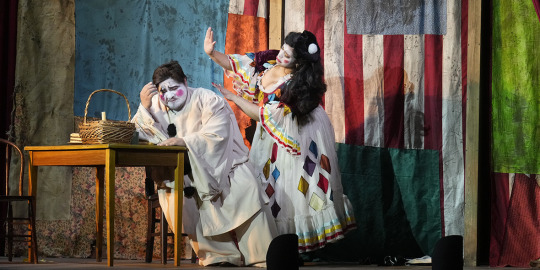
anyway, so if you're staging something like tosca which was part of that verismo movement, then yes, you could reasonably stake the claim that going about it from the angle of 'everything is meant to happen as if it were happening in real life with real people' is the traditional one. but that leaves 272 years of opera history in which 'realism' didn't exist, and therefore... there were 272 years in which 'traditional' productions as we know them didn't really exist.
let's whip around to an opera that 'traditional' staging is particularly egregious to apply to: our good old, fairy-tale-potential-allegory friend, the magic flute!
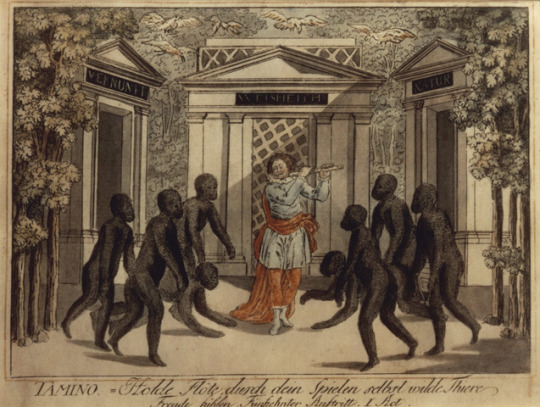
'what the fuck is happening in that image? is it racist?' no, IN THIS CASE the magic flute is not being racist. those dubious dark shapes are meant to be animal costumes. this is part of a set of early engravings by the schaffer brothers of the first magic flute production, which are invaluable both in researching this opera and opera production history as a whole. this is the scene in which tamino charms the animals with the titular flute, in the year of our lord 1791, and they decided to have it look like this!
anyway, once romanticism kicks into gear in a couple decades magic flute productions start taking a turn with it. remember at this time 'the magic flute is meant to happen in egypt' was still something everyone was sticking to, so we end up with these interpretations of magic flute set designs:
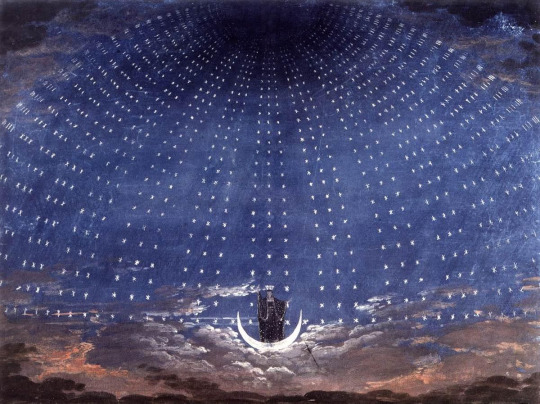
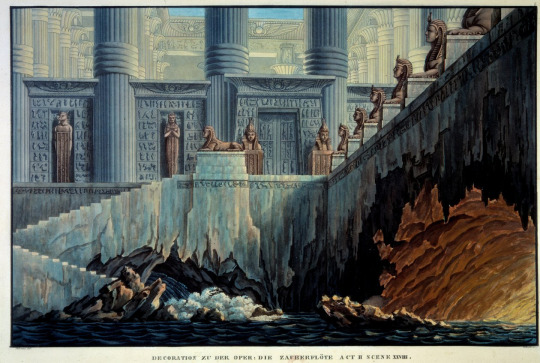
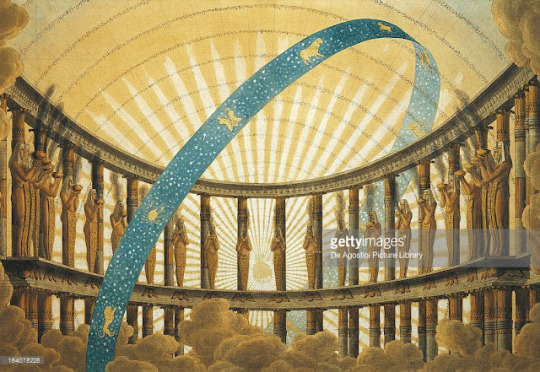
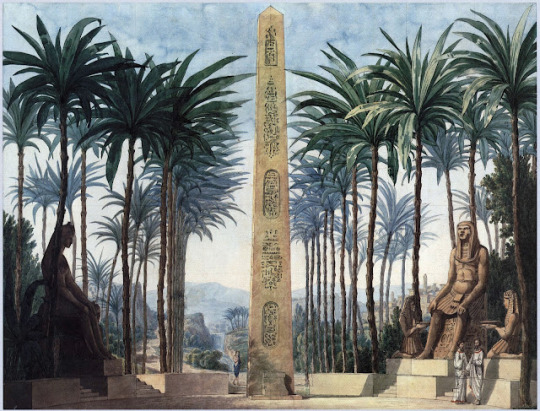
you've probably seen at least a couple of these before because that one on the top left is one of the most famous opera set designs ever. anyway, the design philosophy here between these productions, because there's at least two included here, is weird. there's like 3 things going on: you've got the aptitude for spectacle, this vague orientalist approach towards ancient egypt that was influenced by then-recent discoveries but still very obviously rooted in exoticism, and the cosmic abstraction you can see both in the famous hall of stars and sarastro's temple.
all very interesting! but still not 'traditional'! these, at the time, were a radical re-interpretation of mozart's work- compare them to the above engraving. but because these illustrations have a gorilla grip on the public consciousness they superseded the original 'a bunch of skintight suits constitutes animal costumes' production, and now when an opera company wants to go 'traditional' with their magic flute they do this:
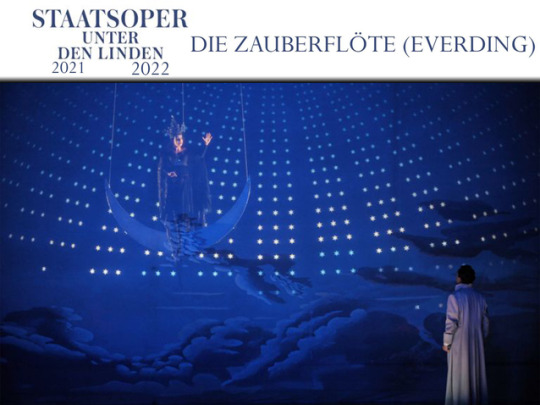
hello my good friend august everding! anyway this is seen as the 'traditional' production out of the two magic flutes in repertory at the berlin staatsoper and yet this isn't what the opera originally even looked like- this is a negotiation with the later early romantic illustrations of the work. sure, it's 'traditional' in the sense that you look at that and immediately know what opera that is meant to be. but at the same time was it ever mozart's intention to stage the magic flute on this grand a scale? is this 'traditional' production really in the spirit of the mozart opera designed for a much smaller stage and with a much smaller set? famously mozart is dead so we will never know.
but then that brings us to the question of What would an actually 'traditional' magic flute look like? well we have multiple options here. first, we have ingmar bergman's film version of the opera, which is sort of the equivalent direction-wise of an opera nature cam. modeled after the drottningholm theatre, this recording tries as hard as it can to emulate the magic flute as it might have been seen in the 18th century:
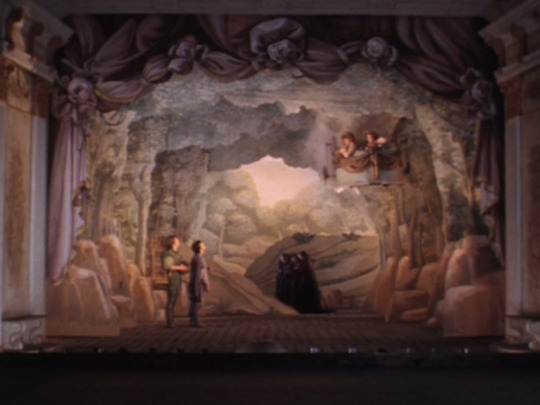
i mean that does look very 18th century, and wouldn't be out of place with the above engraving. but there's still a fatal flaw here: the magic flute was written as an opera for everybody, and was performed not in the drottningholm (which belonged to the swedish royal family and which resides in their palace) but in the theatre auf der weiden, which was, while certainly impressive (trap doors! fly systems!) also a commoner theatre where everyone could just go hang out and watch fairy tale operas. this is a great snapshot in time of what a 18th century magic flute should have looked like. but what would a 21st century magic flute that still adheres to the original 'vision'- no grand sets, no massive theatres, performed by a cast that isn't even entirely opera singers, done with a bunch of jokes meant to appeal to an everyday audience- look like?
well the good news is we might have an idea with the matchbox magic flute, which is on tour right now and which i hope continues to run on said tour.
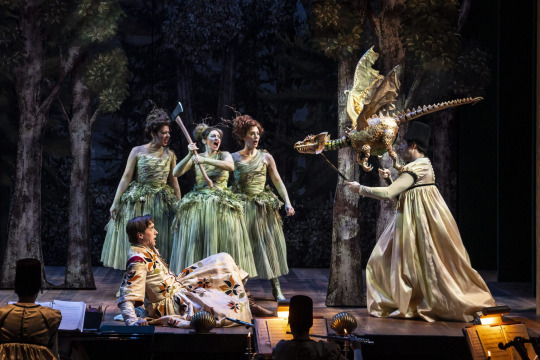
the matchbox magic flute is the magic flute. it's also not really the magic flute. this is technically an adaptation. it's also not really though. this is the closest i have ever gotten to being in a theatre, watching this opera (which i have seen many times at this rate) and thinking 'shit, yeah, this is what the theatre auf der weiden must have been like all those years ago'. the matchbox magic flute scales down the whole thing into a very small orchestra and ten singers, who alternate roles like crazy. it is designed for very tiny theatres. most of the cast do not sing opera! they have a few classically-trained singers in there but it's actually sung, in modern english, mostly by musical theatre performers. the jokes are regularly updated; since i saw it in chicago, there were jokes about the evening commute on lake shore drive. parts of the plot are entirely updated or worked around.
and yet, it reflects the original design vision of the original magic flute and what mozart and schikaneder set out to accomplish so perfectly, i almost WANT to say that in some way this too is traditional.
(also, they should put tamino in a dress forever and ever. he gets to twirl it even. really good.)
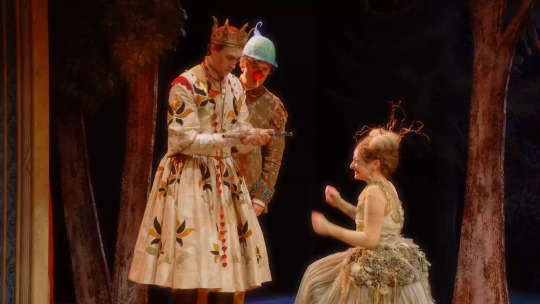
So, what have we learned here. well for one thing 'traditional' productions, as a catch-all category, don't exist. is a traditional magic flute the one based on the early 19th century designs, or the one based on what 18th century theatre would have been like exactly, or the one that tries to reflect its original spiritual vision?
It's all of them because traditionalism as a term is an inherently reactionary term that upholds a time in operatic history that never really existed and which rapidly changes meaning based on the personal values of who is ascribing it, often forgetting that every opera production represents a negotiation and not a reproduction and that the notion of how it ought to be is one of the most dangerous ideas someone in the arts can have. Go watch who's afraid of modern art by jacob geller on youtube and come back to me.
588 notes
·
View notes
Text





YEAH smurfs
#the smurfs#jokey smurf#greedy smurf#brainy smurf#lazy smurf#grouchy smurf#back on my smurfs bs L O L#watchin magic flute man why don’t the smurfs hop around more often#doodles
88 notes
·
View notes
Text
Tonight’s episode had so many great moments, but I REALLY appreciate the little pan flute sound they use for Monty’s guidance nod.
75 notes
·
View notes
Text
Hey, your boyfriend, we're kind of initiating him into the mysteries of Isis. Yeah the reason he wasn't saying anything to you was because part of the initiation involves a period of not being allowed to talk to women, sorry.
#oc#The Magic Flute#Sarasto my dude you got two main characters to nearly kill themselves I think you need to dial it back a little
85 notes
·
View notes
Text






Mozart was crazy. Flat fucking crazy. Batshit, I hear.
#characters and musicality#next to normal#the magic flute#the history boys#natalie goodman#tim walker#donald scripps#eleanor worthington cox#jack wolfe#jamie parker#I'm pretty sure Caissie can play the piano but not sure if she ever played a character that did#also i can't seem to even find a video of her playing#if you have one I would love to see it#so this goodman family can be finally complete#also pardon my non existent editing skills
75 notes
·
View notes